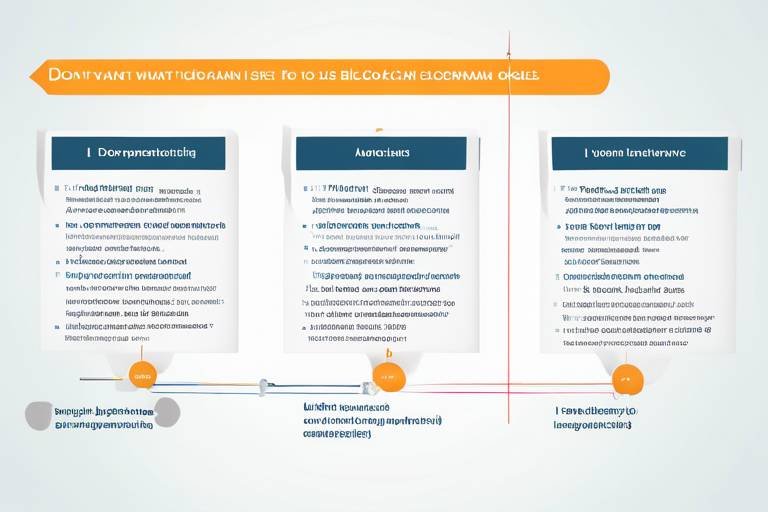How to Design User-Centric Blockchain Solutions
In today's digital age, blockchain technology has emerged as a revolutionary force, reshaping industries and redefining how we think about data security and transparency. However, the true potential of blockchain can only be unlocked when we prioritize the user experience. Imagine a world where blockchain isn't just a buzzword but a seamless part of our daily lives—where users feel empowered, secure, and informed. To achieve this, we must focus on creating user-centric blockchain solutions that cater to the needs and preferences of individuals, ensuring that technology serves us, not the other way around.
Designing user-centric blockchain solutions involves a comprehensive understanding of user needs, accessibility, and security. It’s not just about building a robust system; it's about crafting an experience that resonates with users on multiple levels. In this article, we'll delve into the principles and strategies that can help developers and designers create blockchain applications that are not only functional but also intuitive and engaging. By the end, you’ll see how prioritizing user experience can lead to greater adoption and satisfaction in the blockchain ecosystem.
So, what does it mean to be user-centric in the context of blockchain? It means putting the user at the heart of the design process, ensuring their needs drive the development of the technology. This approach requires a deep dive into understanding user behaviors, preferences, and pain points. By actively engaging with users—through surveys, interviews, and usability testing—we can gather invaluable feedback that informs our design choices. The goal is to create solutions that are not only technically sound but also resonate with users, making them feel comfortable and confident in using blockchain technologies.
As we navigate through this complex landscape, we’ll explore various aspects of user-centric design, including accessibility for diverse populations, the implementation of intuitive interfaces, and the importance of educating users about blockchain technology. Each of these elements plays a crucial role in ensuring that blockchain solutions are not just accessible to a select few but can be embraced by all. In the following sections, we'll break down these principles and provide actionable strategies that developers can implement to create truly user-centric blockchain experiences.

Understanding User Needs
This article explores the principles and strategies for creating blockchain solutions that prioritize user experience, ensuring accessibility, security, and functionality in various applications.
Identifying user needs is crucial in designing effective blockchain solutions. When we think about blockchain technology, we often get lost in the complexities of its underlying mechanics, but the real magic happens when we put ourselves in the users' shoes. Have you ever tried to use a product that felt like it was designed for someone else? Frustrating, right? That’s why understanding user needs should be the foundation of your design process. To start, consider conducting user interviews or surveys. These tools can provide invaluable insights into what users are looking for in a blockchain application. Ask them about their pain points, preferences, and expectations. This information can help you create a more tailored experience that resonates with your audience.
Another effective method is to analyze user behavior through analytics tools. By tracking how users interact with your existing applications, you can pinpoint areas for improvement. For instance, if you notice that users frequently abandon a specific feature, it might indicate that it's too complex or not meeting their needs. This kind of data-driven approach can guide your design decisions and ensure that you’re addressing real issues rather than assumptions.
Furthermore, it’s essential to create user personas. These are fictional characters that represent your ideal users based on real data. By developing personas, you can better understand the motivations, goals, and challenges of different user segments. This practice not only helps in tailoring your blockchain solutions but also ensures that you’re considering the diverse backgrounds and experiences of your users. For example, a persona might represent a tech-savvy millennial who values speed and efficiency, while another could depict an older user who prioritizes simplicity and security. By keeping these personas in mind, you can create solutions that cater to a broad audience.
Lastly, don't underestimate the power of iterative testing. Once you have a prototype of your blockchain solution, gather feedback from users and make adjustments based on their input. This cycle of testing and refining can uncover insights that you might have missed during the initial design phase. It’s like sculpting a statue; you chip away at the rough edges until you reveal the masterpiece underneath. By continuously engaging with your users, you ensure that your blockchain solution evolves alongside their needs.
In summary, understanding user needs is not a one-time task but an ongoing journey. By actively seeking feedback, analyzing behavior, creating user personas, and engaging in iterative testing, you can design blockchain solutions that truly resonate with your users. Remember, the goal is to create a product that not only meets their needs but also enhances their overall experience with blockchain technology.
- What is the importance of user feedback in blockchain design?
User feedback is crucial as it provides insights into user experiences, preferences, and pain points, allowing designers to create more effective solutions. - How can I gather user needs effectively?
Methods such as surveys, interviews, and user behavior analytics can help you gather comprehensive information about user needs. - What are user personas, and why are they important?
User personas are fictional representations of your target audience. They help designers understand the diverse needs and challenges of different user segments. - Why is iterative testing necessary?
Iterative testing allows you to refine your product based on real user feedback, ensuring that the final solution is user-friendly and effective.

Prioritizing Accessibility
When it comes to designing user-centric blockchain solutions, prioritizing accessibility is not just a checkbox item—it's a fundamental principle. Imagine walking into a store where the aisles are too narrow, the signs are hard to read, and the staff is unhelpful. Frustrating, right? This experience mirrors what many users face when engaging with blockchain applications that are not designed with accessibility in mind. To create an environment where everyone can participate, regardless of their abilities or tech-savviness, we need to adopt a comprehensive approach to accessibility.
One of the first steps is to conduct thorough user research to understand the diverse needs of your audience. This can include surveys, interviews, and usability testing with individuals from various backgrounds, including those with disabilities. By gathering this feedback, you can identify specific barriers that users may encounter. For instance, some users may struggle with complex jargon or navigational challenges, while others might require assistive technologies to interact with the interface effectively.
To ensure that blockchain solutions are usable by everyone, consider implementing the Web Content Accessibility Guidelines (WCAG). These guidelines provide a solid framework for creating content that is perceivable, operable, understandable, and robust. By adhering to these principles, you can enhance the overall user experience. Here are some key strategies to focus on:
- Use clear language: Avoid technical jargon and use plain language to make your content more approachable.
- Color contrast: Ensure that text is easily readable against background colors by adhering to recommended contrast ratios.
- Keyboard navigation: Design interfaces that can be navigated using a keyboard alone, accommodating users who cannot use a mouse.
- Alt text for images: Provide descriptive alt text for images to assist users who rely on screen readers.
Moreover, it's essential to think about the various devices users may employ to access blockchain applications. With the increasing use of mobile devices, ensuring that your solution is accessible on smartphones and tablets is critical. Responsive design techniques, such as fluid grids and flexible images, can help create a seamless experience across different screen sizes. This way, users can engage with your application whether they are at home on a desktop or on the go with their mobile device.
Finally, consider the importance of ongoing user education and support. Accessibility doesn't stop at launch; it's an ongoing commitment. Providing comprehensive resources, such as tutorials and FAQs, can empower users to navigate your blockchain solution confidently. Think of it as offering a guiding hand to those who might feel overwhelmed by the technology. By fostering an inclusive environment, you not only broaden your user base but also enhance the overall perception of blockchain technology as a whole.
To further assist readers, here are some frequently asked questions regarding accessibility in blockchain solutions:
- What are the main accessibility challenges in blockchain technology? Many users face issues with complex interfaces, lack of clear instructions, and compatibility with assistive technologies.
- How can I test my blockchain application for accessibility? Conduct usability testing with diverse users, including those with disabilities, and utilize automated accessibility testing tools.
- Are there specific guidelines I should follow for accessibility? Yes, the Web Content Accessibility Guidelines (WCAG) provide a comprehensive framework for creating accessible content.

Implementing Intuitive Interfaces
When it comes to designing user-centric blockchain solutions, is absolutely essential. Imagine walking into a room filled with complex machinery, where every button and lever is labeled in a foreign language. Frustrating, right? That’s how many users feel when they encounter poorly designed blockchain applications. An intuitive interface acts as a friendly guide, leading users through the intricacies of blockchain technology with ease.
The first step in creating an intuitive interface is to understand the user journey. This involves mapping out how users will interact with your application from start to finish. By identifying potential pain points and obstacles, you can streamline the experience, making it as smooth as butter. For instance, consider using a simple onboarding process that introduces users to the main functions of the application without overwhelming them with information.
Another key aspect is the use of familiar design patterns. Users are accustomed to certain layouts and navigation styles from popular applications. By incorporating these familiar elements, you can reduce the learning curve significantly. For example, using a hamburger menu for navigation or placing action buttons in predictable locations can make your blockchain application feel more approachable.
Moreover, visual hierarchy plays a crucial role in guiding the user’s attention. By emphasizing the most important elements—like call-to-action buttons or critical information—you can help users focus on what matters most. Utilizing contrast and size effectively can draw attention to these elements, ensuring they don’t get lost in the shuffle.
To illustrate these points, let’s break down some best practices for intuitive interface design:
- Simplicity is Key: Avoid clutter. A clean design with ample white space can make information digestible.
- Feedback Mechanisms: Implement visual or auditory feedback to inform users of their actions, such as confirmations after a transaction.
- Consistent Terminology: Use language that resonates with your audience. Avoid jargon that might confuse users unfamiliar with blockchain.
Finally, testing is an integral part of the design process. Conduct usability tests with real users to gather feedback on your interface. This iterative approach allows you to refine the design based on actual user experiences, ensuring that the final product meets their needs and expectations.
In conclusion, implementing intuitive interfaces in blockchain solutions is not just about aesthetics; it’s about creating a seamless user experience. By focusing on user journeys, familiar design patterns, visual hierarchy, and continuous testing, you can develop applications that empower users rather than frustrate them. After all, the goal is to make the complex world of blockchain technology accessible to everyone.
Q1: What is an intuitive interface?
An intuitive interface is a user-friendly design that makes it easy for users to navigate and interact with an application without needing extensive instructions.
Q2: Why is user feedback important in interface design?
User feedback is crucial as it provides insights into how real users interact with the application, allowing designers to make informed improvements based on actual experiences.
Q3: How can I test the intuitiveness of my interface?
You can conduct usability tests, where real users perform tasks using your application while observing their interactions. This helps identify areas of confusion or difficulty.
Q4: What are some common mistakes to avoid in interface design?
Common mistakes include overloading the interface with information, using complex jargon, and neglecting mobile responsiveness. Keeping the design simple and user-focused can mitigate these issues.

Visual Design Principles
When it comes to creating user-centric blockchain solutions, play a pivotal role in enhancing the overall user experience. Think of visual design as the first impression you make at a party; it sets the tone for everything that follows. A well-designed interface not only attracts users but also guides them through the complexities of blockchain technology with ease.
One of the fundamental aspects of visual design is the color scheme. Colors evoke emotions and can significantly influence user behavior. For instance, using blue tones can instill a sense of trust and security, while vibrant colors like orange can encourage action. It's essential to choose a color palette that aligns with your brand and resonates with your target audience. A harmonious color scheme can make the interface feel cohesive and inviting.
Next up is typography. The fonts you choose are more than just letters on a screen; they convey your brand's personality. Readability is key—users should be able to scan text quickly without straining their eyes. Consider using a combination of serif and sans-serif fonts to create a visual hierarchy. For example, headings could be bold and larger, while body text remains simple and clean. This approach not only improves readability but also helps users navigate through different sections of your application.
Another critical component is the layout. A well-structured layout guides users' eyes naturally across the interface. Think of it as a roadmap; if it's cluttered and confusing, users may feel lost. Utilize grids to create balance and alignment, ensuring that elements are proportionately spaced. Additionally, incorporating white space is vital. It allows users to breathe and focus on essential content without feeling overwhelmed. Too much information crammed into a small space can lead to decision fatigue, which is the last thing you want.
To illustrate these principles, consider the following table that summarizes key visual design elements:
| Design Element | Best Practices |
|---|---|
| Color Scheme | Choose colors that evoke the right emotions and ensure accessibility for color-blind users. |
| Typography | Use readable fonts and maintain a clear hierarchy to guide users. |
| Layout | Implement a grid system and utilize white space to improve navigation. |
Lastly, keep in mind that visual design isn't just about aesthetics; it's about creating a functional experience. Regularly testing your design with real users can provide invaluable insights. Gather feedback on what works and what doesn’t, then iterate based on this information. Just like a chef perfecting a recipe, continuous improvement leads to a more user-friendly blockchain solution.
- What are visual design principles? Visual design principles refer to the fundamental guidelines that help create aesthetically pleasing and functional interfaces.
- Why is color important in design? Color influences emotions and can impact user behavior, making it essential for creating a positive user experience.
- How can I test my visual design? Conduct usability testing with real users to gather feedback on your design's effectiveness and make necessary adjustments.

Responsive Design Techniques
In today's digital landscape, where users access applications from a myriad of devices, implementing is no longer optional; it’s essential. Imagine trying to read a book that changes its size and format every time you turn a page—frustrating, right? That’s what users feel when they encounter a blockchain application that isn’t optimized for their device. The goal of responsive design is to ensure that your blockchain solutions provide a seamless user experience, regardless of whether someone is using a smartphone, tablet, or desktop computer.
One of the foundational principles of responsive design is the use of flexible grids and layouts. By employing a grid system that adjusts according to the screen size, you can create a fluid experience that makes content easily accessible. For instance, using CSS media queries allows developers to apply different styling rules based on the device's characteristics. This means that images can resize, text can reflow, and navigation can adapt, all contributing to a more user-friendly interface.
Additionally, media queries play a crucial role in responsive design. They enable developers to define breakpoints at which the layout of the application changes. These breakpoints are typically based on common screen sizes, ensuring that your blockchain app looks good on everything from a small mobile screen to a large desktop monitor. For example, a three-column layout on a desktop can transform into a single-column layout on mobile, simplifying navigation and enhancing readability.
Moreover, consider the use of flexbox and CSS Grid for creating responsive layouts. These modern CSS techniques allow for more control over the alignment and distribution of space among items in a container, making it easier to create complex layouts that remain adaptable. Flexbox is particularly useful for one-dimensional layouts, while CSS Grid excels in two-dimensional layouts, giving you the flexibility to design intricate interfaces that adjust beautifully across devices.
It’s also vital to optimize images and media for different screen sizes. Large images can slow down load times, especially on mobile devices, leading to a poor user experience. By using responsive images, which automatically scale based on the user's screen resolution, you can significantly enhance performance. The srcset attribute in HTML allows you to specify different image sources for different display conditions, ensuring that users always receive the best possible quality without unnecessary data consumption.
Lastly, testing is an integral part of implementing responsive design techniques. Regularly testing your blockchain application on various devices and screen sizes helps identify potential issues and allows for adjustments to be made before users encounter them. Tools like Google’s Mobile-Friendly Test can provide insights into how well your application performs on mobile devices, ensuring that you’re continually optimizing for the best user experience.
In conclusion, responsive design techniques are essential for creating user-centric blockchain solutions. By focusing on flexible layouts, utilizing media queries, optimizing images, and conducting thorough testing, you can ensure that your application is accessible and enjoyable for all users, no matter how they choose to engage with your technology.
- What is responsive design?
Responsive design is an approach to web design that makes web pages render well on a variety of devices and window or screen sizes. - Why is responsive design important for blockchain applications?
It ensures that users can access and interact with the application seamlessly, regardless of their device, enhancing overall user experience. - What tools can I use to test responsive design?
Tools like Google’s Mobile-Friendly Test, BrowserStack, and responsinator.com are great for testing how your application looks on different devices.

User Education and Support
When it comes to blockchain technology, one of the biggest hurdles isn't just the technology itself but the understanding of it. Many users feel overwhelmed by the complexities of blockchain, which can lead to hesitation in adoption. That's why user education and support are not just beneficial; they are essential. Imagine trying to navigate a new city without a map or GPS. You'd likely feel lost and frustrated, right? The same goes for users exploring blockchain solutions without adequate education and guidance.
To truly empower users, we need to provide them with resources that demystify blockchain technology. This means developing comprehensive educational materials that break down the concepts into digestible chunks. For instance, creating tutorial videos, interactive webinars, and easy-to-read guides can make a significant difference. Users should feel like they have a solid understanding of how blockchain works and how it can benefit them personally.
Moreover, having a robust support system in place is equally important. Users should have access to customer service representatives who are knowledgeable and can answer their questions in a clear and friendly manner. Think of it as having a knowledgeable friend who can guide you through the intricacies of a new platform. This is where a combination of live chat support, email assistance, and an extensive FAQ section can come into play. By offering multiple channels for support, users can choose the method that suits them best, enhancing their overall experience.
Additionally, consider creating a community forum where users can ask questions and share their experiences. This not only fosters a sense of belonging but also allows users to learn from one another. When users see that they are part of a community, it encourages them to engage more deeply with the technology. After all, people love to share their stories and tips, and this can create a rich repository of knowledge that benefits everyone.
In summary, user education and support are the cornerstones of successful blockchain adoption. By providing clear educational resources and a strong support system, we can help users feel confident and informed as they navigate this innovative technology. As we move forward, let's remember that a well-informed user is not just a satisfied user; they are also a loyal advocate for the technology.
- What is blockchain technology?
Blockchain technology is a decentralized digital ledger that records transactions across many computers securely and transparently.
- How can I educate myself about blockchain?
There are numerous resources available, including online courses, tutorials, and community forums dedicated to blockchain education.
- What support options are available for blockchain users?
Support options typically include live chat, email assistance, and community forums where users can ask questions and share experiences.

Ensuring Security and Privacy
In today's digital landscape, ensuring security and privacy in blockchain solutions is not just an afterthought; it's a necessity. Users are becoming increasingly aware of the importance of safeguarding their personal information, and as developers, it's our responsibility to create systems that prioritize these aspects. Imagine a world where your data is as safe as a treasure locked away in a vault. That’s the level of security we should aim for in our blockchain applications.
To achieve this, we must delve into best practices that not only protect user data but also foster trust in our systems. One of the foundational elements of security in blockchain technology is data encryption. By utilizing robust encryption methods, we can ensure that sensitive information remains confidential and is only accessible to authorized parties. For instance, techniques such as Advanced Encryption Standard (AES) and RSA encryption are widely recognized for their effectiveness in securing data. Implementing these methods can be likened to creating a digital fortress around user information, making it nearly impossible for unauthorized individuals to breach.
Moreover, it's essential to educate users about the importance of security measures in place. When users understand how their data is protected, they are more likely to engage with the platform confidently. Providing clear and accessible information about security protocols can significantly enhance user trust. This could include detailed explanations of how encryption works, what measures are taken to prevent data breaches, and how users can protect themselves while using the platform.
Another critical aspect of ensuring security and privacy is maintaining transparency in operations. Users should have a clear understanding of how their data is collected, stored, and utilized. This transparency can be achieved through regular updates, clear privacy policies, and open communication channels. For example, consider implementing a user-friendly dashboard that allows users to view and manage their data preferences. This not only empowers users but also builds a sense of trust and accountability.
Here’s a quick overview of some key security practices to consider:
- Regular Security Audits: Conducting periodic assessments of your blockchain system can help identify vulnerabilities before they become serious threats.
- Multi-Factor Authentication: Implementing multi-factor authentication adds an extra layer of security, making it more challenging for unauthorized users to gain access.
- User Education: Providing resources and training for users on best practices for maintaining their security can go a long way.
Ultimately, ensuring security and privacy in blockchain solutions is about creating a safe haven for users. By adopting stringent security measures, fostering transparency, and prioritizing user education, we can build solutions that not only meet user needs but also instill confidence in the technology. As we move forward, let’s remember that a secure blockchain is not just a technical achievement; it’s a commitment to our users.
Q1: Why is security important in blockchain technology?
A1: Security is crucial because blockchain systems often handle sensitive user data. Without proper security measures, this information can be compromised, leading to data breaches and loss of user trust.
Q2: What are some common encryption methods used in blockchain?
A2: Common encryption methods include Advanced Encryption Standard (AES), RSA encryption, and elliptic curve cryptography. These techniques help protect data from unauthorized access.
Q3: How can users protect their data when using blockchain applications?
A3: Users can protect their data by using strong, unique passwords, enabling multi-factor authentication, and being cautious about the information they share online.

Data Encryption Methods
When it comes to user-centric blockchain solutions, ensuring the security of sensitive information is not just a feature; it’s a necessity. Think of data encryption as the digital equivalent of a vault. Just as you wouldn’t leave your valuables in plain sight, you certainly don’t want your personal data exposed to potential threats. By employing robust encryption methods, blockchain developers can create an environment where users feel safe and secure while interacting with their applications.
There are several encryption techniques that can be utilized within blockchain systems. Each method has its own strengths and is suited for different scenarios. For instance, asymmetric encryption uses a pair of keys—a public key for encryption and a private key for decryption. This method is particularly effective for secure communications, ensuring that only the intended recipient can access the information. On the other hand, symmetric encryption relies on a single key for both encryption and decryption, which can be faster and more efficient for large datasets but requires secure key management.
Moreover, hashing plays a crucial role in data integrity. Hash functions convert data into a fixed-size string of characters, which is unique to the original data. If even a tiny change is made to the input, the hash output will be completely different. This property makes hashing an excellent choice for verifying data integrity in blockchain transactions. Imagine it as a fingerprint for your data; it’s unique and can’t be altered without detection.
To give you a clearer understanding, here’s a comparison of the most common encryption methods used in blockchain:
| Encryption Method | Type | Use Case | Pros | Cons |
|---|---|---|---|---|
| Asymmetric Encryption | Public-Key | Secure communications | Highly secure, enables digital signatures | Slower than symmetric encryption |
| Symmetric Encryption | Private-Key | Data storage | Faster processing | Key management can be challenging |
| Hashing | One-Way | Data integrity verification | Ensures data hasn’t been altered | Cannot be reversed to retrieve original data |
Implementing these encryption methods not only protects user data but also builds trust in the blockchain system. Users are more likely to engage with a platform that prioritizes their privacy and security. In a world where data breaches are becoming increasingly common, having strong encryption measures in place is like putting up a fortress around your information. As developers, it’s our responsibility to ensure that users feel confident that their data is safe.
In conclusion, choosing the right encryption methods is vital for creating a secure user-centric blockchain solution. By understanding the various encryption techniques and their applications, developers can design systems that not only protect user data but also enhance overall user experience. After all, a secure platform is a user-friendly platform!
- What is data encryption? - Data encryption is the process of converting information into a code to prevent unauthorized access.
- Why is encryption important in blockchain? - Encryption protects sensitive user data and helps maintain trust in the blockchain system.
- What are the differences between symmetric and asymmetric encryption? - Symmetric encryption uses the same key for encryption and decryption, while asymmetric encryption uses a pair of keys.
- Can hashing be reversed? - No, hashing is a one-way process and cannot be reversed to retrieve the original data.

Building Trust with Transparency
In the world of blockchain, trust is not just a buzzword; it’s the foundation upon which the entire ecosystem stands. When users engage with blockchain solutions, they want to feel confident that their data is handled with care and integrity. One of the most effective ways to cultivate this trust is through transparency. But what does transparency really mean in the context of blockchain, and how can we implement it effectively?
First and foremost, transparency involves making processes and data flows visible to users. This means providing users with clear information about how their data is collected, stored, and utilized. Imagine walking into a restaurant where the kitchen is completely open to the dining area; you can see everything that happens behind the scenes. This level of visibility not only reassures diners about the quality of their food but also builds a sense of trust. Similarly, in blockchain applications, allowing users to see how their data is processed can significantly enhance their trust in the system.
One practical approach to achieving transparency is through the use of smart contracts. These self-executing contracts with the terms of the agreement directly written into code can be audited by anyone. By allowing users to view the code and understand the terms, you empower them with knowledge and control. This accessibility demystifies the technology and fosters a sense of security. A well-implemented smart contract can serve as a public assurance that the rules are being followed without the need for a trusted intermediary.
Another important aspect of transparency is communication. Regularly updating users about changes, improvements, or any incidents that may affect their data can go a long way in building trust. Consider creating a dedicated section within your application where users can check the latest updates or view reports about system performance and security audits. This not only keeps users informed but also demonstrates that you value their trust and are committed to maintaining it.
Furthermore, incorporating user feedback into your development process can enhance transparency. When users feel that their opinions are valued and that they have a say in how the system evolves, they are more likely to trust the platform. You could establish a feedback loop through surveys, forums, or community discussions. This engagement not only provides valuable insights for improving your blockchain solution but also reinforces the idea that user input is crucial to your operations.
Lastly, consider the role of educational resources. Providing users with easy-to-understand documentation, tutorials, and FAQs can demystify blockchain technology and its functionalities. When users understand how the system works and what to expect, they are less likely to feel intimidated or suspicious. Offering clear, concise information can help bridge the knowledge gap and empower users to make informed decisions.
In conclusion, building trust through transparency in blockchain solutions is not just a one-time effort; it’s an ongoing commitment. By making processes visible, communicating openly, incorporating feedback, and providing educational resources, you can create a user-centric blockchain environment that fosters trust and encourages widespread adoption. Remember, in the blockchain world, trust is the currency that holds everything together.
- What is the importance of transparency in blockchain?
Transparency helps build trust among users by providing clear visibility into how their data is handled and processed. - How can smart contracts contribute to transparency?
Smart contracts allow users to audit agreements and processes directly, ensuring that all terms are clear and followed without intermediaries. - What role does user feedback play in building trust?
User feedback is essential for improving systems and demonstrating to users that their opinions matter, fostering a sense of community and trust. - How can educational resources enhance user trust?
Providing accessible documentation and tutorials helps users understand blockchain technology, reducing intimidation and increasing confidence in the system.
Frequently Asked Questions
- What are user-centric blockchain solutions?
User-centric blockchain solutions prioritize the needs and experiences of users in their design and functionality. This means considering how users interact with the technology, ensuring it's accessible, secure, and easy to use. The goal is to create applications that not only perform well but also feel intuitive and engaging to the end user.
- How can I identify user needs for my blockchain project?
Identifying user needs can be done through various methods, such as conducting surveys, interviews, and usability testing. Engaging with potential users early in the development process helps gather invaluable feedback that can guide design decisions. Analyzing this feedback allows you to tailor your blockchain solution to meet specific user requirements effectively.
- What techniques ensure accessibility in blockchain applications?
To ensure accessibility, consider implementing features like screen reader compatibility, keyboard navigation, and simplified user interfaces. It's also essential to provide clear instructions and support for users with varying levels of tech-savviness. By focusing on these areas, you can create a more inclusive experience for all users, including those with disabilities.
- Why is user education important in blockchain?
User education is crucial because blockchain technology can be complex and intimidating for many. Providing educational resources, tutorials, and support can empower users to understand how to navigate blockchain systems effectively. This not only enhances user experience but also fosters trust and encourages broader adoption of the technology.
- What are the best practices for ensuring security in blockchain solutions?
Best practices for ensuring security include implementing robust data encryption methods, regular security audits, and maintaining transparent processes. By safeguarding user data and being open about how it is handled, you can build trust and confidence in your blockchain application. Always stay updated on the latest security protocols to protect against vulnerabilities.
- How does transparency build trust in blockchain technology?
Transparency builds trust by allowing users to see how their data is used and managed within the blockchain system. When users understand the processes behind their interactions, they are more likely to feel secure and confident in the technology. Implementing clear communication about data handling practices is key to fostering this trust.



















